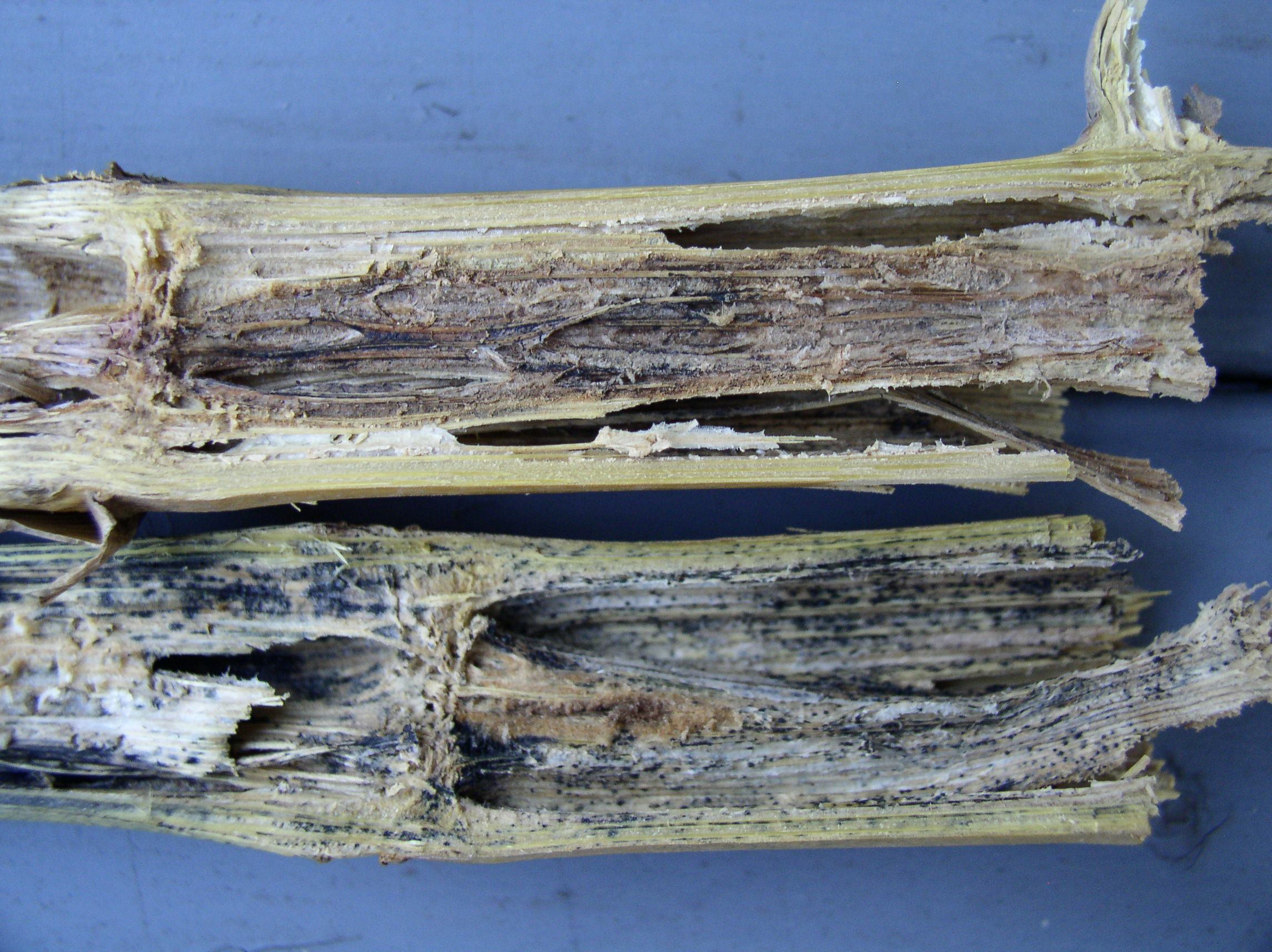
Charcol Rot of Maize
Introduction
Macrophominaphaseolina (Tassi) Goid. asoilborne fungus causes charcoal rot. The fungus can infect the root and lower stem of over 500 plant species . Charcoal rot is an important disease during hot, dry weather or when unfavorable environmental conditions stress the plant. M. phaseolina causes disease on soybean, peanut, and corn. Charcoal rot causes a stalk rot during hot, dry conditions in maize.
Symptoms:
Corn- Charcoal rot in corn produces symptoms similar to other fungal stalk rots. The characteristic sign of charcoal rot is the production of black microsclerotia in the vascular tissue and inside the rind of the stalk. The stalk will appear gray to black in color. Infection of corn occurs during drought conditions when the corn stalks begin to senesce. This leads to widespread disease incidence in corn during hot and dry years.
Disease Cycle and Epidemiology
M. phaseolina survives as microsclerotia in the soil and on infected plant debris. The microsclerotia serve as the primary source of inoculum and have been found to persist within the soil up to three years (4). The microsclerotia are black, spherical to oblong structures that are produced in the host tissue and released in to the soil as the infected plant decays. These multi-celled structures allow the persistence of the fungus under adverse conditions such as low soil nutrient levels and temperature above 30 C. Microsclerotial survival is greatly reduced in wet soils surviving no more than 7 to 8 weeks and mycelium no more than 7 days. Seeds may also carry the fungus in the seed coat. Infected seed do not germinate or produce seedlings that die soon after emergence.
Germination of the microsclerotia occurs throughout the growing season when temperatures are between 28 and 35 C. Microsclerotia germinate on the root surface, germ tubes form appresoria that penetrate the host epidermal cell walls by mechanical pressure and enzymatic digestion or through natural openings (2). The hyphae grow first intercellularly in the cortex and then intracellularly through the xylem colonizing the vascular tissue. Once in the vascular tissue M. phaseolina spreads through the taproot and lower stem of the plant producing microsclerotia that plug the vessels (8). The rate of infection increases with higher soil temperatures and low soil moisture will further enhance disease severity.
Hot, dry weather promotes infection and development of charcoal rot (8). In soybean charcoal rot is a greater problem after anthesis and often occurs when the plant is under drought stress (4). M. phaseolina can grow and produce large amounts of microsclerotia under relatively low water potentials allowing this disease to be recognized as favoring drought (6). The mechanical plugging of the xylem vessels by microsclerotia, toxin production, enzymatic action, and mechanical pressure during penetration lead to disease development. The population of M. phaseolina in soil will increase when susceptible hosts are cropped in successive years and can be redistributed by tillage practices (8).
Management
Cultural management methods must be implemented to minimize charcoal rot damage since there are no fungicides available for effective disease control.
Crop rotation out of a susceptible host is effective in some crop production systems. Rotation out of soybeans for three years may effectively reduce microsclerotia numbers and is useful for managing charcoal rot (7). Corn is also a host for M. phaseolina but isolates appear to be specific to each crop (soybean and corn) though all isolates can infect both crops. Corn is not as good of a host to M. phaseolina as soybean so rotation with corn for three years may help reduce populations but not eliminate the pathogen from the soil. Rotation with a poor host such as cotton may only require one or two years to reduce inoculum levels in soil. For peanuts rotation with cotton or rice for two to three years may help reduce soilborne inoculum.
Early Planting will aid in earlier canopy closure that will help reduce soil temperatures and therefore reduce the competitive ability of M. phaseolina.
Avoid high plant populations. High plant populations can contribute to increase plant stress and competition for water increasing charcoal rot potential.
Fertility. Adequate levels of available P and K will reduce nutrient stress and encourage health plant growth.
Soil Moisture. Tillage practices which reduce soil moisture stress may reduce disease potential. Maintaining good soil moisture with irrigation from planting to pod fill may reduce disease potential.


